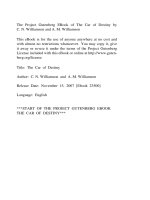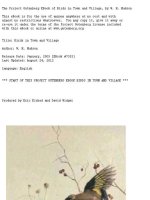The Project Gutenberg EBook of Ohio Biological Survey, Bull. 10, Vol. 11, No. 6, by Bruce Fink pdf
Bạn đang xem bản rút gọn của tài liệu. Xem và tải ngay bản đầy đủ của tài liệu tại đây (1.49 MB, 190 trang )
The Project Gutenberg EBook of Ohio
Biological Survey, Bull. 10, Vol. 11,
No. 6, by Bruce Fink and Leafy J.
Corrington
This eBook is for the use of anyone
anywhere at no cost and with
almost no restrictions whatsoever. You may
copy it, give it away or
re-use it under the terms of the Project
Gutenberg License included
with this eBook or online at
www.gutenberg.org
Title: Ohio Biological Survey, Bull. 10,
Vol. 11, No. 6
The Ascomycetes of Ohio IV and V
Author: Bruce Fink and Leafy J. Corrington
Release Date: July 4, 2006 [EBook #18754]
Language: English
*** START OF THIS PROJECT GUTENBERG EBOOK
OHIO BIOLOGICAL SURVEY ***
Produced by Charlene Taylor, La Monte H.P.
Yarroll, Taavi
Kalju and the Online Distributed
Proofreading Team at
Volume II, No. 6 Bulletin No. 10
OHIO BIOLOGICAL
SURVEYTHE ASCOMYCETES
OF OHIO IV
THE
LECIDEACEAE
By BRUCE FINK
THE ASCOMYCETES
OF OHIO V
THE
PELTIGERACEAE
By LEAFY J.
CORRINGTON
Published by
THE OHIO STATE UNIVERSITY
Columbus,
1921
THE ASCOMYCETES OF
OHIO IV
[A]
The Lecideaceae.
Bruce Fink.
GENERAL
CONSIDERATIONS
It was stated in the second paper of this
series that the disposition of the
Lecideaceae in an early paper of the
series would show what slight changes
are needed in treating lichens as we treat
other ascomycetes. It is hoped that this
paper has accomplished this in
phraseology intelligible to those
acquainted with the present-day language
of systematic mycology.
T h e Lecideaceae form a well-defined
family of lichens, the affinities of which
seem plainly marked. In apothecial
structure, and so far as known, in structure
of the sexual reproductive areas, the
family seems to be closely related to the
mainly non-lichen Patellariaceae and to
such lichens as the Gyalectaceae, the
Lecanactidaceae, the Collemaceae, the
Baeomycetaceae, and the Cladoniaceae.
Following the commonly-accepted theory
that the lichens have been evolved from
non-algicolous fungi, the origin of the
Lecideaceae and related lichens from
Patellaria-like ancestors is a reasonable
supposition, though the relative rank of the
various related families named in the last
paragraph is not easy to decide. Within the
Lecideaceae, the line of evolution seems
to have been in the direction of a well-
developed exciple and from simpler to
more complex spores. With the advance in
these two directions has gone a slightly
increased development of the thallus.
In structure, the thallus is crustose, and the
thalli vary from inconspicuous, evanescent
conditions to those which are conspicuous
and sometimes even subsquamulous.
Rarely the thallus extends upward as a
veil which surrounds the apothecia
laterally and suggests how the thalloid
exciple of higher families probably arose.
As usual in crustose forms, the thalli are
composed of hyphae which are densely
disposed toward the upper, exposed
surface and more loosely disposed toward
the lower surface (Fig. 2).
The apothecial evolution passes from
forms with weak, light-colored exciples
and soft texture (Fig. 10) to those with
strong, dark exciples, which are firm in
texture (Fig. 11). The superficial
apothecial characters are so much alike in
many of the species that one cannot
always feel certain even of the genus of
unfamiliar forms until he has studied them
microscopically.
The paraphyses are commonly distinct in
young apothecia, but in mature apothecia
they are usually more or less gelatinized
and coherent. In some of the species, they
become so gelatinized that they form a
homogeneous mass about the asci, in
which the individual paraphyses are no
longer discernible. When distinct, the
paraphyses are sometimes branched, most
commonly toward their apices (Fig. 1 and
12).
There is great diversity with respect to
spore development, the whole range of
spore structure, from minute, simple,
hyaline spores to those which are large,
brown, and muriform being found within
the family (Figs. 3, 4, 5, 6, 7, 8, 9, and
13). This condition makes it appear quite
possible that the family may be
polygenetic.
The genus, Biatorella, contains non-lichen
forms and is probably as a whole more
closely related to the Patellariaceae than
to the Lecidiaceae. However, our two
species, both of which are lichens, are
herein admitted to the latter family.
Through one or more species with larger
spores than are usually found in this genus,
Biatorella approaches Lecidea. Starting
with Lecidea, we have a natural series in
spore development with intermediate
conditions difficult to place. The series
runs thus: Lecidea with simple hyaline
spores (Fig. 3) ; Biatorina with two-
celled, hyaline spores (Fig. 4) ; Bilimbia
with several-celled, hyaline spores, not
much narrowed (Fig. 5); and Bacidia with
several-celled, hyaline, acicular spores
(Fig. 6) . Buellia and Rhizocarpon are
aberrant genera, brown-spored, and
closely related among themselves (Figs. 8,
9, and 13). Through Buellia, the two
genera are related to Rinodina of the
Physciaceae. The two aberrant genera are
like other members of the Lecideaceae
with respect to thallus development and
general apothecial characters, the
aberrancy being with respect to the
spores, on which account the two genera
are placed in another family, the
Buelliaceae, by some workers, perhaps
with sufficient reason.
The algal host is Pleurococcus-like (Fig.
2, c) in nearly all species of the
Lecideaceae; but the host cells are so
hypertrophied and distorted that their
generic rank is often difficult to ascertain,
except by cultivation outside of the lichen
thallus. The algal-host cells are few in
number in some of the species and are
sometimes absent during a portion of the
life history of the lichen. The host is
usually found throughout the superficial
portions of the thallus, except near the
upper surface, from which portion the
algae are usually absent, except in a dead
or dying condition, difficult to detect.
The writer has collected the Lecideaceae,
with other fungi, in Butler County for
fifteen years, and has worked for the Ohio
Biological Survey in Preble, Warren,
Highland, Fairfield, Adams, Hocking, and
Lake counties. Besides these collections
made by the writer, a few specimens were
examined from Champaign, Hamilton,
Wayne, Morgan, Madison, Muskingum,
Franklin, Vinton, and Summit counties. Of
the 37 species treated in this paper, 24
had not been reported from Ohio
previously.
Systematic Account.
LECIDEACEAE
Thallus crustose, without
plectenchymatous cortex (Fig. 2, a),
varying from granulose and often
evanescent to conspicuous, areolate, or
even subsquamulose conditions, attached
to the substratum by hyphal rhizoids (Fig.
2, d), and in a few instances extending up
as a veil and surrounding the apothecia
laterally, the hyphae densely interwoven
toward the upper surface, but more
loosely disposed below (Fig. 2, a and b);
apothecia usually minute or small,
commonly rounded, the exciple weak and
obscure (Fig. 10, d), or more strongly
developed when conspicuous and much
darker in color (Fig. 11, b); hypothecium
varying from hyaline to dark brown (Fig.
10, b and Fig. 11, c); hymenium almost
always lighter and commonly hyaline
(Figs. 10 and 11, a); paraphyses usually
simple, but branched forms to be found
frequently (Figs. 1 and 12), pale
throughout or darkened toward the
sometimes enlarged apex, commonly more
or less coherent and indistinct at maturity;
spores simple and hyaline to muriform and
brown (Figs. 2, 3, 4, 5, 6, 7, 8, 9, and 13).
KEY TO THE GENERA
Spores minute, numerous in
each ascus
Biatorella, p.
Spores larger, usually 8 in
each ascus,
Spores hyaline.
Spores one-celled
(simple)
Lecidea, p.
Spores more than one-
celled (compound).
Spores 2-celled Biatorina, p.
Spores 4- to
several-celled.
Spores ellipsoid,
fusiform, or dactyloid
Bilimbia, p.
Spores acicular Bacidia, p.
Spores brown, or
becoming brown.
Spores 2-celled Buellia, p.
Spores 4-celled and
becoming muriform
Rhizocarpon,
p.
Biatorella De Not. Giorn. Bot. Ital. 21.
192. 1846.
Thallus granulose to verrucose and
subareolate, sometimes inconspicuous and
evanescent; apothecia minute to middle-
sized, adnate or more or less immersed,
exciple usually prominent and persistent,
but sometimes becoming covered, disk flat
to convex; hypothecium and hymenium
pale to brown; spores simple, hyaline,
minute, numerous in each ascus.
KEY TO THE SPECIES OF
BIATORELLA
The whole apothecium dark 1. B.
colored simplex
The disk of the apothecium
white-pruinose
2. B.
pruinosa
1. Biatorella simplex (Dav.) Br. & Rostr.
Bot. Tidssk. 3: 241 1869.
Lichen simplex Dav. Trans. Linn. Soc.
Lond. 2: 283 pl. 28. f. 2. 1794.
Thallus thin and smooth or thicker and
roughened, sometimes subareolate, ash-
white to green-gray and darkening, rarely
disappearing; apothecia minute to middle-
sized, 0.2 to 0.8 mm. in diameter, adnate,
scattered or crowded, rounded or
variously irregular, black but usually dark
red when damp, flat or slightly convex, the
thin exciple raised and persistent;
hypothecium light or darker brown;
hymenium pale or tinged brown;
paraphyses semi-distinct to coherent-
indistinct; asci cylindrico-clavate; spores
oblong-ellipsoid, 3 to 5 mic. long and 1 to
1.5 mic. wide.
Collected in Butler, Adams, Montgomery,
Hocking, and Ross counties. On
limestone. Not previously reported from
Ohio, but probably frequent where there is
limestone, though inconspicuous and
easily overlooked.
2. Biatorella pruinosa (J.E. Smith) Mudd
Man. Brit. Lich. 191. 1861.
Lichen pruinosus J.E. Smith in Sowerby,
Eng. Bot. 32: pl. 2244 1811.
Thallus light colored, usually thin and
smooth, rarely disappearing; apothecia
minute to middle-sized, 0.2 to 1 mm. in
diameter, adnate scattered or crowded,
flat or slightly convex, the disk pruinose,
and the exciple persistent; hypothecium
lighter or darker brown; hymenium usually
pale; paraphyses coherent and becoming
indistinct; asci cylindrico-clavate; spores
oblong-ellipsoid, 3 to 5 mic. long and 1 to
1.5 mic. wide.
Collected in Butler and Adams counties.
On limestone. Not previously reported
from Ohio, but often occurring with the
last in limestone areas.
Lecidea Ach. Meth. Lich. XXX. 32. pl. 2.
f. 1, 2. 1803.
Thallus smooth, roughened, or verrucose,
in some species chinky to areolate, or
even subsquamulose, rarely rudimentary
and evanescent; apothecia minute to
middle-sized, usually adnate, but rarely
sessile or immersed, with pale to black,
and flat to strongly convex disk; exciple
and hypothecium from pale to dark brown
in section; hymenium lighter, most
commonly pale; spores simple, hyaline, 8
in each ascus.
KEY TO THE SPECIES OF LECIDEA
Exciple soft, usually
light colored.
Apothecia usually
surrounded by a
thalloid veil
1. L. coarctata
Apothecia not
surrounded by a
thalloid veil.
Exciple becoming
covered.
Hypothecium
pale or pale yellow.
Apothecia
always minute.
Spores 5
to 7 mic. long
2. L. intropallida
Spores 7
to 15 mic. long
3. L. varians









